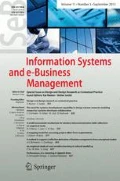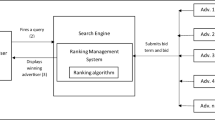Abstract
Reinforced by the fast growth of electronic commerce, even during the current global economic downturn, intermediated online targeted advertising (IOTA) has emerged as a promising electronic business model empowered by the Web 2.0 principle. IOTA maximizes the profit of online targeted advertising services by displaying the proper banner contents to certain types of Web users in real time in order to increase the click-through rate (CTR). However, due to severe competition in the online advertising market, the principles and algorithms of IOTA remain highly confidential. This paper is intended to unveil the nature of IOTA. We propose an IOTA service system framework and present its implementation scheme. Specifically, we address the advertisement allocation problem, using an advertisement ranking mechanism and considering the ads impression quota and the time-of-day (TOD) effect. Simulation results show that advertisement ranking in a subset of clusters that actively estimates the quota situation is feasible and efficient.






Similar content being viewed by others
Notes
Click-through rate is widely used to measure the effect of online advertisements. CTR is the ratio of the number of users who clicked on an ad on a Web page to the number of times the ad was delivered (impressions).
Actually, many studies in other areas have revealed that the TOD effect is a sine wave, but not a simple sine wave (Hursh 2003).
References
Adam SA (2002) Model of web use in direct and online marketing strategy. Electron Mark 12(4):262–269
Adams M (1995) Brands of gold. Mediaweek 13:30–32
Adler M, Gibbon P, Matias Y (2002) Scheduling space-sharing for internet advertising. J Sched 5(2):103–119
Amiri A, Menon S (2003) Efficient scheduling of internet banner advertisement. ACM Trans Internet Technol 3(4):334–346
Bayus BL, Mehta RA (1995) Segmentation model for the targeted marketing of consumer durables. J Mark Res 17:463–469
Bhatnagar A, Papatla P (2001) Identifying locations for targeted advertising on the internet. Int J Electron Commer 5(3):23–44
Bruner RE (2005) The decade in online advertising 1994–2004. April 2005, DoubleClick white paper, retrieved on March 11, 2007, from http://www.doubleclick.com/us/knowledge_central/documents/RESEARCH/dc_decaderinonline_0504.pdf
Chatterjee P, Hoffman DL, Novak TP (2003) Modeling the clickstream: implications for web-based advertising efforts. Mark Sci 22(4):520–541
Chickering D, Heckerman D (2003) Targeted advertising on the web with inventory management. INFORMS J Interfaces 33(5):71–77
Cho C-H (2003) Factors influencing clicking of banner ads on the WWW. Cyberpsychol Behav 6(2):201–215
Danaher PJ (1992a) A Markov-chain model for multivariate magazine-exposure distributions. J Bus Econ Stat 10(4):401–407
Danaher PJ (1992b) Some statistical modeling problems in the advertising industry: a look at media exposure. Am Stat 46(4):254–270
Dunne MP, Roche F (1990) Effects of time of day on immediate recall and sustained retrieval from semantic memory. J Gen Psychol 117(4):403–411
eMarketer (2001) CPM, CTR, CPA, etc. Available at: http://www.emarketer.com/estatnews/estats/emailmarketing/20010327ctrcpmetc.html?ref=wn
eMarketer (2004) Measuring online advertising’s effectiveness. eMarketer daily special research report, July 28, 2004. http://www.emarketer.com/Report.aspx?code=on_ad_eff_jul04. Accessed July 2007
Feng J, Bhargava HK, Pennock DM (2007) Implementing sponsored search in web search engines: computational evaluation of alternative mechanisms. INFORMS J Comput 19(1):137–148
Fortin DR, Dholakia RR (2005) Interactivity and vividness effects on social presence and involvement with a web-based advertisement. J Bus Res 58:387–396
Gallagher K, Parsons J (1997) A framework for targeting banner advertising on the internet. In: Proceedings of 30th Hawaii international conference on system sciences (HICSS) vol 4: information systems track—internet and the digital economy, pp 265–274
Huang C, Lin C (2006) Modeling the audience’s banner ad exposure for internet advertising planning. J Advert 35(2):123–136
Hursh SR (2003) System and method for evaluating task effectiveness based on sleep pattern. US patent issued on June 17. Available at: http://www.patentstorm.us/patents/6579233-fulltext.html
Idemudia EC, Jin K, Lin Z (2007) A nonlinear programming model for optimizing intermediated online targeted advertising services. In: Proceedings of MSOM 2007, June 18–19, Beijing, China
Interactive Advertising Bureau (2007) IAB internet advertising revenue annual report. Retrieved on March 11, 2008, from http://www.iab.net/media/file/2007-annual-report.pdf
Interactive Advertising Bureau (2008) IAB internet advertising revenue annual report. Retrieved on July 16, 2009, from http://www.iab.net/media/file/IAB_PwC_2008_full_year.pdf
Kumar S, Varghese S, Jacob B, Sriskandarajah C (2006) Scheduling advertisements on a web page to maximize revenue. Eur J Oper Res 173:1067–1089
Kumar S, Milind D, Mookerjee VS (2007) Optimal scheduling and placement of internet banner advertisements. IEEE Trans Knowl Data Eng 19(11):1571–1584
Lange S, Van LP, Geue D, Hatzmann W, Grönemeyer D (2005) Influence of gestational age, heart rate, gender and time of day on fetal heart rate variability. Med Biol Eng Comput 43(4):481–486
Li K, Yu Y, Jin K, Idemudia EC, Lin Z (2007) Theoretical approach to implementing intermediated online targeted advertising. In: Proceedings of Web2007, Montreal, Canada, December 12
Moore RS, Stammerjohan CA, Coulter RA (2005) Banner advertiser-web site context congruity and color effects on attention and attitudes. J Advert 34(2):71–84
Roehm HA, Roehm ML (2004) Variety-seeking and time of day: why leader brands hope young adults shop in the afternoon, but follower brands hope for morning. Market Lett 15(4):213–221
Schwarz P (1984) The estimated effects on industry of time-of-day demand and energy electricity prices. J Ind Econ 32(4):523–539
Shen F (2002) Banner advertisement pricing, measurement, and pretesting practices: perspectives from interactive agencies. J Advert 16(3):61–67
Spiliopoulou M, Mobasher B, Berendt B, Nakagawa M (2003) A framework for the evaluation of session reconstruction heuristics in web-usage analysis. INFORMS J Comput 15(2):171–191
Srivastava J, Cooley R, Deshpande M, Tan P (2000) Web usage mining: discovery and applications of usage patterns from web data. SIGKDD Explor 1(2):12–15
Wilkie WL (1990) Consumer behavior, 2nd edn. Wiley, New York
Wirl F (1990) Optimal introduction of time-of-day tariffs in the presence of consumer adjustment costs. J Econ 51(3):259–271
World Wide Web Committee (1999) World wide web committee web usage characterization activity. W3C working draft: web characterization terminology and definitions sheet. Available at: http://www.w3.org/1999/05/WCA-terms/
Acknowledgment
We are grateful to Dr. Kai Jin for her involvement in the early stage of this research project.
Author information
Authors and Affiliations
Corresponding author
Rights and permissions
About this article
Cite this article
Li, K., Idemudia, E.C., Lin, Z. et al. A framework for intermediated online targeted advertising with banner ranking mechanism. Inf Syst E-Bus Manage 10, 183–200 (2012). https://doi.org/10.1007/s10257-010-0134-4
Received:
Revised:
Accepted:
Published:
Issue Date:
DOI: https://doi.org/10.1007/s10257-010-0134-4




